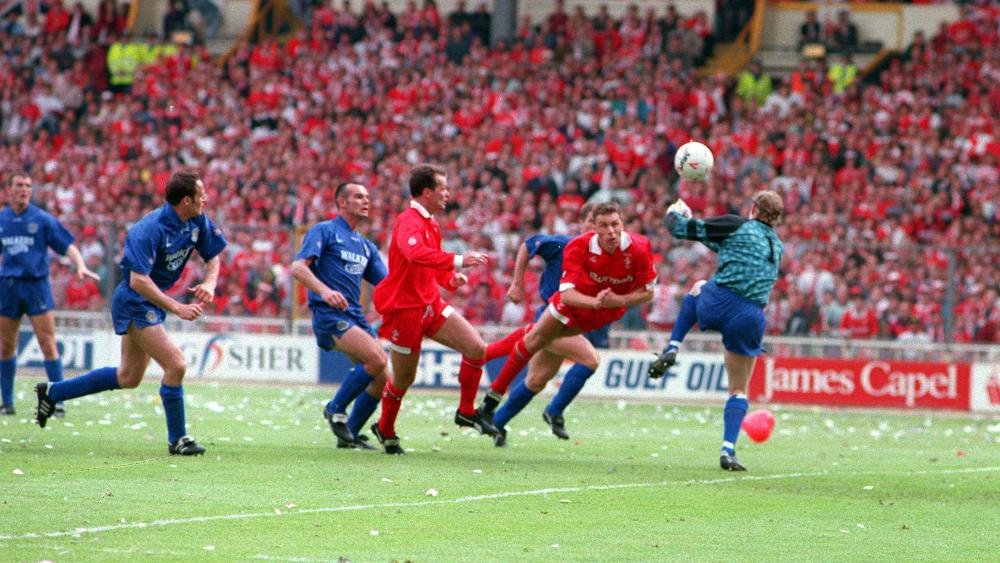With the Guardian’s unstoppable rise to global dominance** we at Guardian US thought we’d run a series of articles for fans wishing to improve their knowledge of the sport’s history and storylines, hopefully in a way that doesn’t patronise you to within an inch of your life. A warning: If you’re the kind of person that finds The Blizzard too populist this may not be the series for you.
** Actual dominance may not be global. Or dominant
Advertisement
The English Football League play-offs were introduced at the start of the 1986-87 season. So, having established that fact, let’s park the idea completely, and go a further century back, all the way to Victorian times, and the birth of the Football League itself.
The Football League was launched in 1888, and while its round-robin system of home and away games seems so glaringly obvious now – so watertight, so perfect – it’s easy to forget that at some point in time it didn’t exist, and some poor guy had to come up with the idea in the first place.
Getting there took a bit of feeling around in the dark, accompanied by some abject failure. For example, a rival competition was set up by clubs not part of the nascent Football League. The Combination involved 20 clubs, but nobody put much thought into what any of them were combining with or for. Each would play eight matches against eight other sides in the division, and, er, that’s it. Clubs were told to make their own arrangements, and with no central planning or subsequent guidance, this exercise in cat herding descended into high farce and was dissolved before the first season could be completed. A tough break for Newton Heath, who were looking good as the form team at the point of annulment; whatever happened to them?
A total fiasco and an affront to sporting integrity, then, albeit one which bears worrying similarities to the new Swiss-style Champions League. Oh the humanity. Will we ever learn?
Advertisement
Related: Wrexham’s success shows that content is now truly king in football
While the Combination was floundering, at least the Football League had their house in order. Even so, when it kicked off, it was thought that the titular table would be ordered by number of wins alone, until someone came up with the bright idea of two points for a win and one for a draw two months later. There wasn’t even a trophy for Preston North End to lift when they secured the title in January 1889.
Everyone was making it all up while flying by the seat of their pants. So when a second tier of the Football League came along in 1892, what to do? Again, it would seem obvious to the modern eye that automatically relegating the worst x number of teams in the First Division and replacing them with a similar number of the best teams from the Second Division was the logical way forward. But that wasn’t sufficiently complex for the hiveminds of the time.
Instead, the Test Matches were born. The first promotion-relegation play-off system in English football history! The bottom three clubs in 1892-93’s First Division played the top three of the all-new Second Division, with a place in the top division the prize for the winners of each Test. Better luck for Newton Heath this time round, as despite finishing bottom of the First, they won their Test with Second Division champions Small Heath (whatever happened to them, part II) after a rematch, 5-2, and retained their status. Darwen, third in the Second Division, beat Notts County, who went down a division, while Second Division runners-up Sheffield United beat Accrington, who resigned from the league then went out of business altogether.
Advertisement
You’ll notice we didn’t say that Sheffield United and Darwen went up, because they didn’t. At least, not immediately, not technically, not automatically, as they then had to be elected to the First Division through the committee. To be clear, they were subsequently given the green flag and granted promotion – any black-balling would have rendered the whole thing an entire waste of time – but what a pompous hoo-hah.
At least the concept of the winner-takes-all Tests were fair and easy enough to understand. So of course the Football League soon set about tweaking the format, and after three years, the Tests morphed into a mini-league of four teams, the bottom two from the First and the top two from the Second. That’s all good and well if it were it a round-robin like the League itself, but it wasn’t, not quite. Instead, each team faced the two clubs from the other division, playing twice, but didn’t get the chance to play the club from their own division at all. Debacle incoming!
Related: Soccer still has the power to leave us in tears. I should know
The problem inherent in this scheme revealed itself during the 1898 Tests, and in some style. The play-off mini-league saw First Division failures Blackburn Rovers and Stoke take on the upwardly mobile Second Division pair of Burnley and Newcastle United. The first Tests panned out in such a manner that when Burnley and Stoke met in their final fixture, they knew that a draw would promote Burnley while also maintaining Stoke’s first-tier status. And there wouldn’t a single thing Blackburn or Newcastle could do about it. Goalless pact ahoy!
Advertisement
The 0-0 draw that followed wasn’t just predictable; it was brazen. There were no shots on goal. Players repeatedly hoofed the ball into touch, occasionally launching “passes” or “shots” out of the ground altogether. From their cynical viewpoint, this carry-on ensured everyone in the ground would be going home happy. But times were hard, the crowd had spent cash money to be entertained, and both sets of fans wanted a proper contest. And so, incensed, and by way of protest, they began fetching and returning all of the balls ballooned into touch; at one point, five were pinging around the field of play. And so football beat pinball to the multiball system by a good 58 years. (Bally’s 1956 game Balls-a-Poppin was the first to do this, since you’re asking.)
“These Test games have proved an utter farce!” hollered an editorial in the Manchester Guardian. “A change of some kind is absolutely necessary if the contests are in future to be regarded with any seriousness.” To this end, after a month of controversy-fuelled to-ing and fro-ing, Football League bosses decided to expand the First Division, apologetically offering Newcastle and Blackburn sympathy promotions. The Tests were abolished, and a simple system of two up, two down, automatically decided by the final league placings, was introduced. You have to wonder why they didn’t just go with this in the first place.
The concept of play-offs didn’t come around again until 1985, when the threat of a breakaway Super League (some things never change) was staved off by a compromise deal which gave more money and voting rights to the bigger clubs (those immutable things, again) and tweaked the Football League’s structure. Play-offs, designed to rejig the size of each division, and to generate a little more dollar with the game struggling pretty much across the board, were the headline-grabber, to be implemented at the start of the 1987-88 season for two years. “I hope it becomes a permanent feature in all divisions,” said Gordon Taylor, the head of the players union. “It gives the end of the season more spice.”
Business-end spice quickly became the order of the day. The format for the first two years of the new play-offs was particularly delicious, each divisional battle involving the team that had finished one place above the automatic relegation spots in the First Division and the three teams below the automatic promotion places in the Second Division. Two-legged semis were followed by a two-legged final. Replays if necessary. Cue a smorgasbord of stories that sizzled with dramatic heat.
Advertisement
In 1987, sleeping giant Leeds United (immutable etc.) were seven minutes from promotion to the First Division in their final replay until Peter Shirtliff scored twice in four minutes to retain Charlton Athletic’s status. A shock – not least because Shirtliff was a jobbing centre-back who, outside those four minutes, scored 13 goals in a 518-match career. But that was nothing compared to the seismic suffering of Sunderland, who were relegated to the Third Division for the very first time in their history after losing their semi-final with Gillingham 6-6 on away goals. The campaign cost Lawrie McMenemy a reputation hard won at Southampton. Not so great, man. Meanwhile in the battle for a place in the Third, Aldershot won promotion having conquered the Wanderers of both Bolton and Wolverhampton, a couple of David v Goliath slingshots of a magnitude scarcely believable now.
Related: New Reading owner Rob Couhig: ‘There is a real market for the EFL in the US’
A year later, Chelsea were surprisingly condemned to the Second Division by Middlesbrough at Stamford Bridge, at which point the on-pitch throwing of hands commenced between home fans and police. But overall, the play-offs had been an unqualified success, and Gordon Taylor got his wish. The Football League voted for more end-of-season spice, keeping the play-offs albeit tweaking them into a fully promotion-facing affair. The teams finishing one place above the automatic relegation spots could breathe again, with the demise of Chelsea and Sunderland having spooked some bigger clubs into dialling down some of that scary jeopardy.
In the end, the play-offs didn’t hold off the advent of a Super League for too long, with the Premier League coming into being in 1992. Nevertheless, the 90s also established the play-offs in the national consciousness, thanks to some of the most absurd and memorable rollercoaster rides in English football history: Swindon holding off a three-goal Leicester fightback in 1993; Steve Claridge volleying Leicester’s winner 11 seconds from time against Crystal Palace in 1996; the eight goals shared between Charlton and Sunderland in 1998, Clive Mendonca’s hat-trick, Michael Gray’s chunked penalty, all that. “I’m gutted,” sighed Charlton’s match-winner Mendonca. “I’m the biggest Sunderland fan in the world. But I’m also a professional footballer and I work for Charlton.” This paper added that it was “the best game played at Wembley in 30 years,” right up there with the 1966 World Cup final and the 1953 Matthews match.
It took a few twists and turns, and no small amount of tweaking and tinkering. But the Football League got there in the end.
Read the full article here














